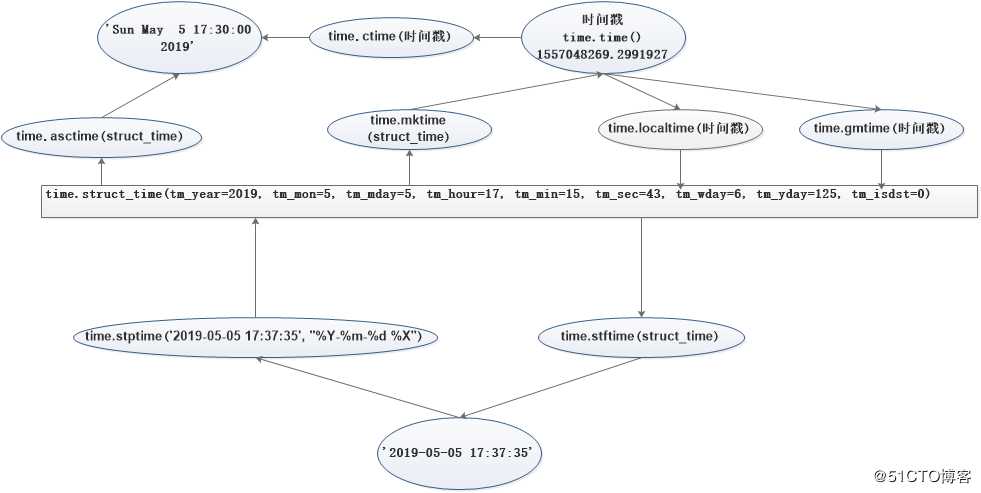time和datetime模块
Posted
tags:
篇首语:本文由小常识网(cha138.com)小编为大家整理,主要介绍了time和datetime模块相关的知识,希望对你有一定的参考价值。
1.在Python中表示时间的方式1.1时间戳
时间戳(timestamp)方式:通常来说,时间戳表示从1970年1月1日00:00:00开始按秒计算的偏移量。运行type(time.time())返回float类型
UTC (Coordinated Universal Time,世界协调时)即格林威治天文时间,世界标准时间。在中国为UTC+8。DST(Daylight Saving Time)即夏令时
>>> import time
>>> type(time.time())
<class ‘float‘>
>>> print(time.time())
1557046718.6016247
1.2.格式化的时间字符串
"2019-05-05"
1.3.元组
元组(struct_time)方式共九个元素。返回struct_time的函数主要有gmtime(),localtime(),strptime()。下面列出这种方式元组中的几个元素
索引(Index) 属性(Attribute) 值(Values)
0 tm_year(年) 比如2011
1 tm_mon(月) 1 - 12
2 tm_mday(日) 1 - 31
3 tm_hour(时) 0 - 23
4 tm_min(分) 0 - 59
5 tm_sec(秒) 0 - 61
6 tm_wday(weekday) 0 - 6(0表示周日)
7 tm_yday(一年中的第几天) 1 - 366
8 tm_isdst(是否是夏令时) 默认为-12.time模块的方法
- time.localtime([secs]):将一个时间戳转换为当前时区的struct_time。secs参数未提供,则以当前时间为准。
>>> time.localtime()
time.struct_time(tm_year=2019, tm_mon=5, tm_mday=5, tm_hour=17, tm_min=15, tm_sec=43, tm_wday=6, tm
_yday=125, tm_isdst=0)
>>> time.localtime()
time.struct_time(tm_year=2019, tm_mon=4, tm_mday=25, tm_hour=23, tm_min=57, tm_sec=32, tm_wday=3, tm_yday=115, tm_isdst=0)
>>> a.tm_year
2019
>>> ‘%s-%s-%s‘%(a.tm_year,a.tm_mon,a.tm_mday)
‘2019-4-26‘- time.gmtime([secs]):和localtime()方法类似,gmtime()方法是将一个时间戳转换为UTC时区(0时区)的struct_time。0时区的时间+8小时是utc+8的时间
>>> time.gmtime()
time.struct_time(tm_year=2019, tm_mon=5, tm_mday=5, tm_hour=9, tm_min=20, tm_sec=41, tm_wday=6, tm_
yday=125, tm_isdst=0)
- time.time():返回当前时间的时间戳。
>>> time.time()
1557048269.2991927
- time.mktime(t):将一个struct_time转化为时间戳。
>>> time.mktime(time.localtime())
1557048434.0
- time.sleep(secs):线程推迟指定的时间运行。单位为秒。
time.sleep(2)- time.asctime([t]):把一个表示时间的元组或者struct_time表示为这种形式:‘Sun Oct 1 12:04:38 2017‘。如果没有参数,将会将time.localtime()作为参数传入。
>>> time.asctime(time.localtime())
‘Sun May 5 17:30:00 2019‘
- time.ctime([secs]):把一个时间戳(按秒计算的浮点数)转化为time.asctime()的形式。如果参数未给或者为None的时候,将会默认time.time()为参数。它的作用相当于time.asctime(time.localtime(secs))。
>>> time.ctime(time.time())
‘Sun May 5 17:34:26 2019‘- time.strftime(format[, t]):把一个代表时间的元组或者struct_time(如由time.localtime()和time.gmtime()返回)转化为格式化的时间字符串。如果t未指定,将传入time.localtime()。
>>> time.strftime("%Y-%m-%d %X", time.localtime())
‘2019-05-05 17:37:35‘- time.strptime(string[, format]):把一个格式化时间字符串转化为struct_time。实际上它和strftime()是逆操作。
>>> time.strptime(‘2019-05-05 17:37:35‘, "%Y-%m-%d %X")
time.struct_time(tm_year=2019, tm_mon=5, tm_mday=5, tm_hour=17, tm_min=37, tm_sec=35, tm_wday=6, tm
_yday=125, tm_isdst=-1)

字符串转时间格式对应表
Meaning Notes
%a Locale’s abbreviated weekday name.
%A Locale’s full weekday name.
%b Locale’s abbreviated month name.
%B Locale’s full month name.
%c Locale’s appropriate date and time representation.
%d Day of the month as a decimal number [01,31].
%H Hour (24-hour clock) as a decimal number [00,23].
%I Hour (12-hour clock) as a decimal number [01,12].
%j Day of the year as a decimal number [001,366].
%m Month as a decimal number [01,12].
%M Minute as a decimal number [00,59].
%p Locale’s equivalent of either AM or PM. (1)
%S Second as a decimal number [00,61]. (2)
%U Week number of the year (Sunday as the first day of the week) as a decimal number [00,53]. All days in a new year preceding the first Sunday are considered to be in week 0. (3)
%w Weekday as a decimal number [0(Sunday),6].
%W Week number of the year (Monday as the first day of the week) as a decimal number [00,53]. All days in a new year preceding the first Monday are considered to be in week 0. (3)
%x Locale’s appropriate date representation.
%X Locale’s appropriate time representation.
%y Year without century as a decimal number [00,99].
%Y Year with century as a decimal number.
%z Time zone offset indicating a positive or negative time difference from UTC/GMT of the form +HHMM or -HHMM, where H represents decimal hour digits and M represents decimal minute digits [-23:59, +23:59].
%Z Time zone name (no characters if no time zone exists).
%% A literal ‘%‘ character.>>> time.strftime("%a",time.localtime())
‘Sun‘
>>> time.strftime("%A",time.localtime())
‘Sunday‘
>>> time.strftime("%b",time.localtime())
‘May‘
>>> time.strftime("%B",time.localtime())
‘May‘
>>> time.strftime("%c",time.localtime())
‘Sun May 5 17:54:45 2019‘
>>> time.strftime("%C",time.localtime())
‘20‘
>>> time.strftime("%d",time.localtime())
‘05‘
>>> time.strftime("%D",time.localtime())
‘05/05/19‘
>>> time.strftime("%H",time.localtime())
‘17‘
>>> time.strftime("%h",time.localtime())
‘May‘
>>> time.strftime("%I",time.localtime())
‘05‘
>>> time.strftime("%i",time.localtime())
Traceback (most recent call last):
File "<stdin>", line 1, in <module>
ValueError: Invalid format string
>>> time.strftime("%j",time.localtime())
‘125‘
>>> time.strftime("%m",time.localtime())
‘05‘
>>> time.strftime("%M",time.localtime())
‘57‘
>>> time.strftime("%p",time.localtime())
‘PM‘
>>> time.strftime("%S",time.localtime())
‘22‘
>>> time.strftime("%U",time.localtime())
‘18‘
>>> time.strftime("%W",time.localtime())
‘17‘
>>> time.strftime("%w",time.localtime())
‘0‘
>>> time.strftime("%x",time.localtime())
‘05/05/19‘
>>> time.strftime("%X",time.localtime())
‘17:58:54‘
>>> time.strftime("%y",time.localtime())
‘19‘
>>> time.strftime("%Y",time.localtime())
‘2019‘
>>> time.strftime("%Z",time.localtime())
‘?D1¨2?à¨o?á?¨o?à??‘
>>> time.strftime("%%",time.localtime())
‘%‘
>>>
3.datetime模块
datetime.date:表示日期的类。常用的属性有year, month, day;
datetime.time:表示时间的类。常用的属性有hour, minute, second, microsecond;
datetime.datetime:表示日期时间。
datetime.timedelta:表示时间间隔,即两个时间点之间的长度。
datetime.tzinfo:与时区有关的相关信息。(这里不详细充分讨论该类,可以参考python手册)"需要记住的"
1.d=datetime.datetime.now() 返回当前的datetime日期类型
d.timestamp(),d.today(), d.year,d.timetuple()等方法可以调用
#!/usr/bin/env python
# -*- coding:utf-8 -*-
# Author: vita
import datetime
d = datetime.datetime.now()
print(d)
print("d.timestamp()",d.timestamp())
print("d.today()",d.today())
print("d.year",d.year)
print("d.timetuple()",d.timetuple())
E:\PythonProject\python-test\venvP3\Scripts\python.exe E:/PythonProject/python-test/BasicGrammer/test.py
2019-05-05 18:11:52.005561
d.timestamp() 1557051112.005561
d.today() 2019-05-05 18:11:52.005561
d.year 2019
d.timetuple() time.struct_time(tm_year=2019, tm_mon=5, tm_mday=5, tm_hour=18, tm_min=11, tm_sec=52, tm_wday=6, tm_yday=125, tm_isdst=-1)
Process finished with exit code 0
2.datetime.date.fromtimestamp(时间戳)把时间戳转换为datetime日期类型
>>> datetime.date.fromtimestamp(1557051112.005561)
datetime.date(2019, 5, 5)
3.时间运算
>>> datetime.datetime.now()
datetime.datetime(2017, 10, 1, 12, 53, 11, 821218)
>>> datetime.datetime.now() + datetime.timedelta(4) #当前时间 +4天
datetime.datetime(2017, 10, 5, 12, 53, 35, 276589)
>>> datetime.datetime.now() + datetime.timedelta(hours=4) #当前时间+4小时
datetime.datetime(2017, 10, 1, 16, 53, 42, 876275)
4.时间替换
#!/usr/bin/env python
# -*- coding:utf-8 -*-
# Author: vita
import datetime
d = datetime.datetime.now()
print(d.replace(year=2020,month=11,day=30))
print("d.timetuple()",d.timetuple())
E:\PythonProject\python-test\venvP3\Scripts\python.exe E:/PythonProject/python-test/BasicGrammer/test.py
2020-11-30 18:16:59.517815
d.timetuple() time.struct_time(tm_year=2019, tm_mon=5, tm_mday=5, tm_hour=18, tm_min=16, tm_sec=59, tm_wday=6, tm_yday=125, tm_isdst=-1)
Process finished with exit code 0
以上是关于time和datetime模块的主要内容,如果未能解决你的问题,请参考以下文章